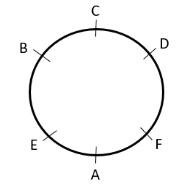2013 September UGC NET Paper 1
Question 1 |
The world population growth rate at a certain reference year was 3.5%. Assuming exponential growth of population, after how many years, the population of the world would have increased by a factor 16 ?
~ 80 years | |
~ 40 years | |
~ 160 years | |
~ 320 years |
Question 2 |
Telephone is an example of
linear communication | |
non-linear communication | |
circular | |
mechanised |
Question 3 |
Means of grapevine communication are
formal | |
informal | |
critical | |
corporate |
Question 4 |
Communication issues at the international level are addressed by
ILO | |
ITU | |
UNDP | |
UNESCO |
Question 5 |
Referential framing used by TV audience connects media with
reality | |
falsity | |
negativity | |
passivity |
Question 6 |
The communicated knowledge in a classroom is considered as
non-pervasive treasure | |
limited judgement | |
autonomous virtue | |
cultural capital |
Question 7 |
Classroom communication is normally considered as
effective | |
affective | |
cognitive | |
non-selective |
Question 8 |
A person writes all the numbers from 0 to 99. The number of times digit 3 will be written is
18 | |
19 | |
20 | |
21 |
Question 9 |
Starting from point A, Ajit walks 14 metres towards west, he then turns to his right and walks 14 metres and then turns to his left and walks 10 metres. He again turns to his left and walks 14 metres and reaches to the point E. The shortest distance between A and E is
38 | |
42 | |
52 | |
24 |
Question 9 Explanation:

Question 10 |
A, B, C, D, E and F are sitting around a round table. A is between E and F. E is opposite to D and C is not in either of the neighbouring seats of E. The person opposite to B is
C | |
D | |
A | |
F |
Question 10 Explanation:
A is between E & F = AEF
The final seating arrangement is represented in figure
 The person opposite to B = F
The person opposite to B = F
The final seating arrangement is represented in figure
 The person opposite to B = F
The person opposite to B = FQuestion 11 |
The missing term in the series 2, 7, 24, 77, ?, 723 is
238 | |
432 | |
542 | |
320 |
Question 12 |
In certain city the Taxi charges comprise of a fixed charge and the charge of the distance travelled. A person paid ` 156 for a journey of 16 km and another person paid ` 204 for the journey of 24 km. The amount paid by a passenger who has travelled 30 km is
236 | |
240 | |
248 | |
256 |
Question 12 Explanation:
Fixed charge = ‘x’ Say
Variable charge = Rs y per km
⇒ x + 16y = 156 → (1)
x + 24y = 204 → (2)
By solving (1) & (2),
x = 60, y = 6
⇒ Cost for travelling distance of 30 km = 60 + 3y
= 60 + 3(6)
= Rs 240
Variable charge = Rs y per km
⇒ x + 16y = 156 → (1)
x + 24y = 204 → (2)
By solving (1) & (2),
x = 60, y = 6
⇒ Cost for travelling distance of 30 km = 60 + 3y
= 60 + 3(6)
= Rs 240
Question 13 |
In certain code HEALTH is written as KHDOWK. The code of NORTH will be
QRUWK | |
RQWUK | |
RWQUK | |
RWUKQ |
Question 13 Explanation:

Question 14 |
Yadav, Arjun, Rajesh and Kamal play cricket. Rajesh and Kamal play tennis but do not play football. Yadav does not play Badminton but play golf. Arjun does not play tennis. Kamal sometimes plays Badminton. Who does play only cricket ?
Yadav | |
Arjun | |
Rajesh | |
Kamal |
Question 15 |
A deductive argument can not be valid :
If its premise / premises is/are true and its conclusion is true. | |
If its premise / premises is /are true and its conclusion is false. | |
If its premise / premises is/are false and its conclusion is false. | |
If its premise / premises is / are false and its conclusion is true. |
Question 15 Explanation:
Deductive argument is not valid when premises true and the conclusion is false.
Ans:- Option B
Ans:- Option B
There are 15 questions to complete.
